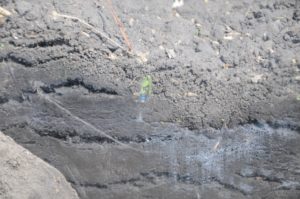July 20, 2015 | Pat Beaujot
Side Band with the Seed Hawk Seeding System is Superior in Dry Conditions
I am hearing some comments out there regarding side band fertilizer placement in dry soil conditions. I would like to challenge the misinformation that is being circulated.
Our competitors like to talk about potential disruption on the seed bed when side banding and this was true when attempting to use one opener to place both the seed and fertilizer. I think Seed Hawk has demonstrated many times over that our dual knife system with 1.5” to the side and .75” below fertilizer separation does not cause any soil fracturing below the shelf created by the seed knife. As shown in the picture below the seed is placed on firm soil allowing for maximum moisture uptake from that firm seed bed.
The other comment that competitors seem to focus on is the potential for the side band fertilizer to slow down germination because it is near the seed. There is no doubt that fertilizer’s affinity for moisture can affect germination, however we have had an independent study done on this using the worst case scenario 12” and 15” row spacing in sandy high Ph soils in South Western MB. The results were that our consistent side band placement on both out twin wing and single side band knives showed no significant difference in plant count or germination timing using up to 120lb/ac of urea.
I think the dual knife side band placement is perfect for dry conditions because we make a furrow that is 1.5” deep then place the seed .75” below that so you are getting the seed 2.25” into the ground but it only has to grow .75” to get to sunlight. At that depth your seed is well into spring moisture and well protected in a furrow that will also funnel water in from any small rains that do occur.
This compared to a middle row band you would only be using one knife for seed going .75” that would make a very small furrow so your seed would only be 1’ below the soil surface vs 2.25” as in our case. In a dry year you could be seeding into or very close to the dry top layer.
The other major issue for middle row systems is what to do with immobile nutrients like Phosphate and Potash? Placing them directly with the seed can prove disastrous, slowing down germination and effecting plant count.
Some growers like to split apply their P placing a bit with the seed but not so much that it affects germination and the rest is placed deeper in the soil in the side band where it is available all season long. You would never want to do that with a middle row band system as that is way too far for roots to go to find the Phosphate they need.
All in all using a Seed Hawk no-till system will be the best insurance against drought.
I invite your comments and questions. Please use the comments feature on the blog to tell me your thoughts, or tweet me @PatrickBeaujot or @NOTILLville .





